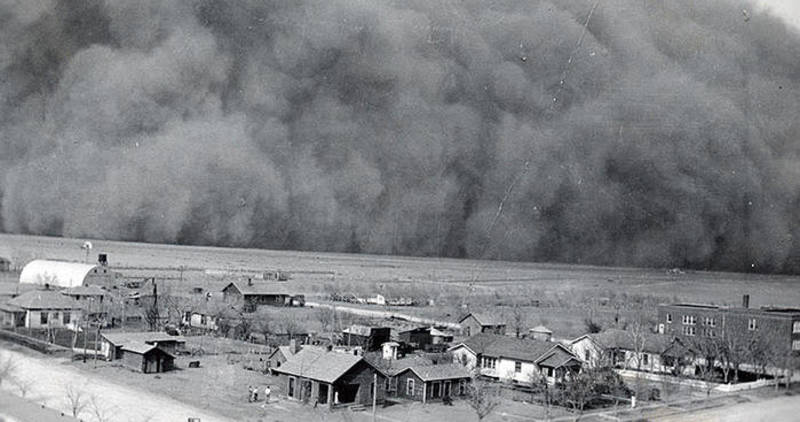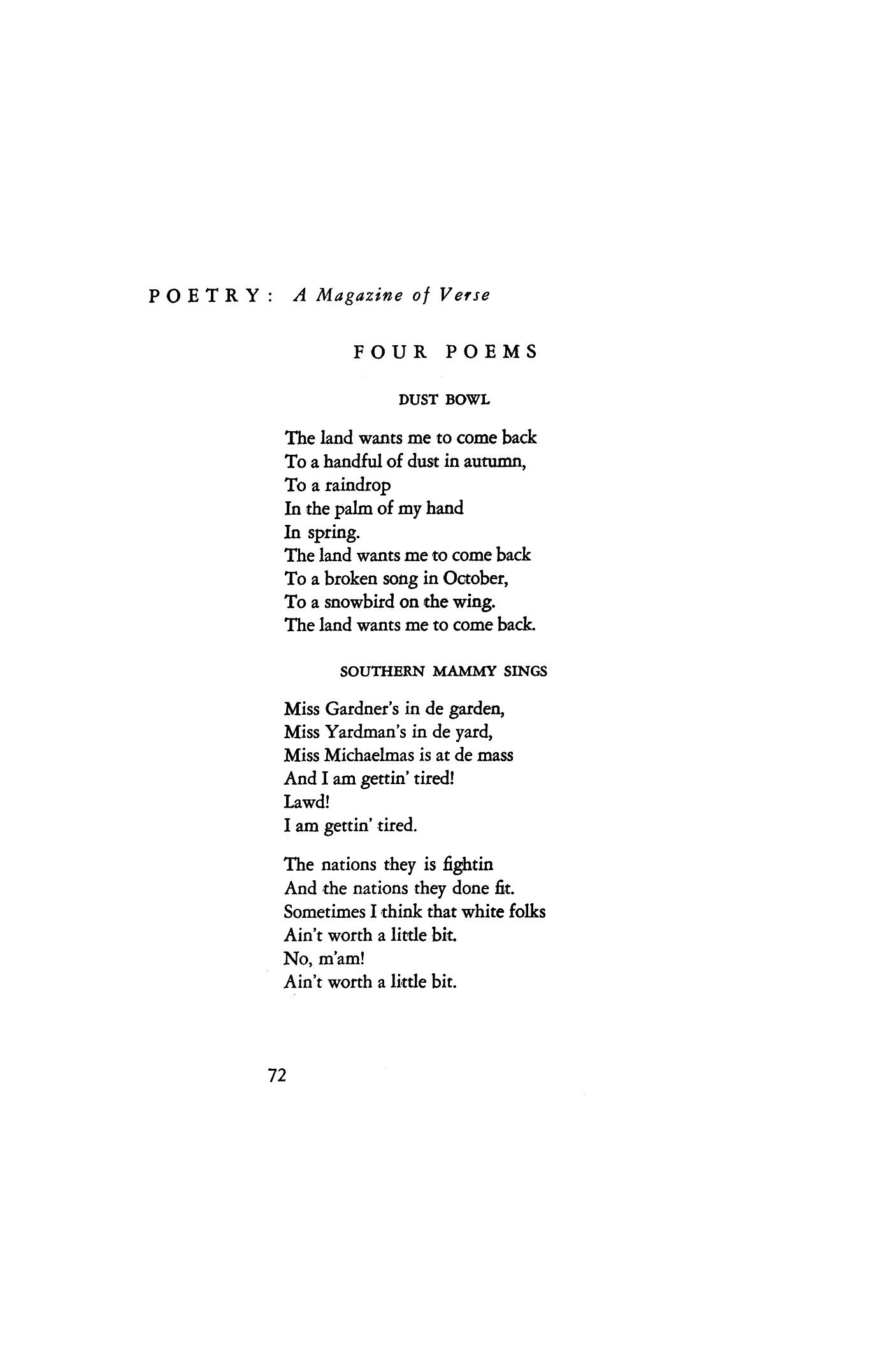Dust Bowl
By Jake Magnuson, Drew Hendrickson, Benjamin Sanvee, and Matthew Makowski
What was it?, What were the causes?, What were the effects?, What was the geographic location?
What was the Dust Bowl?



What is the Dust Bowl?
Short Video of Dust Bowl
The Dust Bowl was a great economic disaster that occurred in the 1930’s. The exact date that the event occurred was on November 11, 1933. A huge dust storm spread across the south-western states for hundreds of miles long. These states included Oklahoma and Texas, along with Colorado, New Mexico, and Kansas. Before the storm, people began to move westward from the east coast; also known as westward expansion. They eventually crossed paths with Great Plains, which had an abundant amount of rich soil. As settlers began to move there, they began to graze their cattle, which means allowing their cows to roam around on the land and eat the prairie grass. The prairie grass was important in the Great Plains because it kept the rich soil in place. If the soil wasn’t in place, it would eventually turn into dust. The Great Plains was especially known for its high speed winds.
One of the main causes for the dust storms was the lack of prairie grass, which was caused by the cows eating the grass. The soil turned into dry dust. Since their was a big drought in the early 1934, 1936, and 1939-40 the dry soil mixed with the heavy wind speeds and created big dust storms. These storms lasted for hours in a day. And continued all throughout the year.
One of the worst dust storms occurred on May 9, 1934. This strong, two-day storm moved massive amounts of topsoil off the ground. The dust clouds blew all the way to Chicago, there it received 12 million tons of dust. The average loss of money per day for the crops was 25 million dollars, which was caused by the dust storms.
Short Video of Dust Bowl
The Dust Bowl was a great economic disaster that occurred in the 1930’s. The exact date that the event occurred was on November 11, 1933. A huge dust storm spread across the south-western states for hundreds of miles long. These states included Oklahoma and Texas, along with Colorado, New Mexico, and Kansas. Before the storm, people began to move westward from the east coast; also known as westward expansion. They eventually crossed paths with Great Plains, which had an abundant amount of rich soil. As settlers began to move there, they began to graze their cattle, which means allowing their cows to roam around on the land and eat the prairie grass. The prairie grass was important in the Great Plains because it kept the rich soil in place. If the soil wasn’t in place, it would eventually turn into dust. The Great Plains was especially known for its high speed winds.
One of the main causes for the dust storms was the lack of prairie grass, which was caused by the cows eating the grass. The soil turned into dry dust. Since their was a big drought in the early 1934, 1936, and 1939-40 the dry soil mixed with the heavy wind speeds and created big dust storms. These storms lasted for hours in a day. And continued all throughout the year.
One of the worst dust storms occurred on May 9, 1934. This strong, two-day storm moved massive amounts of topsoil off the ground. The dust clouds blew all the way to Chicago, there it received 12 million tons of dust. The average loss of money per day for the crops was 25 million dollars, which was caused by the dust storms.
How it began/causes?
How the Dust Bowl started and the causes of it.
https://m.youtube.com/watch?v=MYOmjQO_UMw
 What was it like after the Dust Bowl?
What was it like after the Dust Bowl?
The Dust Bowl caused a lot of people to flee their homes because of the severe dust blows that went over cities and towns. The Dust Bowl mostly effected the southern prairies. The Dust Bowl also helped add to the depression of the Great Depression. After the Dust Bowl the federal government encouraged farmers to make different ways to farm to help conserve the soil. It was considered the worst drought in U.S history.

https://m.youtube.com/watch?v=ClyBKz4sQ28
The Dust Bowl caused lots of bad things in the U.S and it is the greatest well known drought in history and is to be never forgotten.
https://m.youtube.com/watch?v=MYOmjQO_UMw
The dust bowl started in 1930 and lasted for almost a decade. It was caused by many droughts and agricultural practices. It was basically high winds picking up the top soil from the farmlands and prairies and causing severe “black blizzards.” The lands had been deeply plowed and planted for wheat by farmers. The Farmers kept plowing and plowing and nothing would grow.
 What was it like after the Dust Bowl?
What was it like after the Dust Bowl?The Dust Bowl caused a lot of people to flee their homes because of the severe dust blows that went over cities and towns. The Dust Bowl mostly effected the southern prairies. The Dust Bowl also helped add to the depression of the Great Depression. After the Dust Bowl the federal government encouraged farmers to make different ways to farm to help conserve the soil. It was considered the worst drought in U.S history.

https://m.youtube.com/watch?v=ClyBKz4sQ28
The Dust Bowl caused lots of bad things in the U.S and it is the greatest well known drought in history and is to be never forgotten.
Geographical Location


Where it is?
The Dust Bowl is the largest sand storm ever. It was located in the Mid-US which included Montana, North Dakota, South Dakota, Wyoming, Nebraska, Kansa, Colorado, New Mexico, Oklahoma and Texas.
Where did they go after/during the storm?
Some of the people from the dust bowl states went north in states like Washington and Oregon. They also went west to states such as California and Arizona. Some went to western Colorado and Wyoming. And some went to the east coast.
What happened when they migrated?
When the people from the dust bowl migrated there was over 2.5 million people who migrated all over America such as California. California had to shut down the boarder and not let anymore people into the state of California because they were getting over populated.
The Dust Bowl is the largest sand storm ever. It was located in the Mid-US which included Montana, North Dakota, South Dakota, Wyoming, Nebraska, Kansa, Colorado, New Mexico, Oklahoma and Texas.
Where did they go after/during the storm?
Some of the people from the dust bowl states went north in states like Washington and Oregon. They also went west to states such as California and Arizona. Some went to western Colorado and Wyoming. And some went to the east coast.
What happened when they migrated?
When the people from the dust bowl migrated there was over 2.5 million people who migrated all over America such as California. California had to shut down the boarder and not let anymore people into the state of California because they were getting over populated.
Effects of the Dust Bowl


What were the effects of the Dust Bowl?
https://www.pbs.org/video/dust-bowl-environmental-catastrophe/
The Effects of the Dustbowl was very bad and very effective. The effects included of drought, dust, and agricultural damage. The Northern Plains were not so badly affected by it, but the Southern plains were affected by it the most. Also the Dust Bowl helped make the Great Depression longer and that isn’t good. The Great Depression was effected by some world wide but mostly in the United States of America.
More of the effects that is happening with the Dust Bowl is that the dust was basically deadly. The dust came rushing in to peoples lungs and eyes and basically everywhere. The dust gave people lung disease and also killed them too. This effected many people, including the ones who lost there loved ones. Also the dust was so much, it covered the sky and made it dark. The dust was so much it was even getting into peoples food and they couldn’t get it out.
https://www.pbs.org/video/dust-bowl-environmental-catastrophe/
The Effects of the Dustbowl was very bad and very effective. The effects included of drought, dust, and agricultural damage. The Northern Plains were not so badly affected by it, but the Southern plains were affected by it the most. Also the Dust Bowl helped make the Great Depression longer and that isn’t good. The Great Depression was effected by some world wide but mostly in the United States of America.
More of the effects that is happening with the Dust Bowl is that the dust was basically deadly. The dust came rushing in to peoples lungs and eyes and basically everywhere. The dust gave people lung disease and also killed them too. This effected many people, including the ones who lost there loved ones. Also the dust was so much, it covered the sky and made it dark. The dust was so much it was even getting into peoples food and they couldn’t get it out.
Works Cited
Work Cited
Editors, History.com. "Dust Bowl." History.com. 27 Oct. 2009. A&E Television Networks. 05 Mar. 2019 .
On "Spring and All". 05 Mar. 2019 .
Britannica, The Editors of Encyclopaedia. "Dust Bowl." Encyclopædia Britannica. 06 Dec. 2018. Encyclopædia Britannica, inc. 05 Mar. 2019 .
Editors, History.com. "Dust Bowl." History.com. 27 Oct. 2009. A&E Television Networks. 05 Mar. 2019 .
On "Spring and All". 05 Mar. 2019 .
Britannica, The Editors of Encyclopaedia. "Dust Bowl." Encyclopædia Britannica. 06 Dec. 2018. Encyclopædia Britannica, inc. 05 Mar. 2019 .
Trimarchi, Maria. "What caused the Dust Bowl?" HowStuffWorks Science. 08 Mar. 2018. HowStuffWorks. 05 Mar. 2019 .
